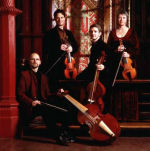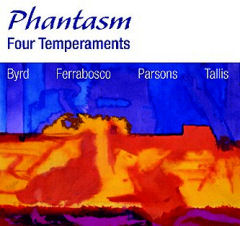| Gramophone magazine - Editor’s Choice, June 2005 Four Temperaments: Thomas Tallis, William Byrd, Robert Parsons, Alfonso Ferrabasco I Phantasm (Laurence Dreyfus, treble viol and director; Wendy Gillespie, treble and tenor viols; Jonathan Manson, tenor viol; Markku Luolajan-Mikkola, bass viol; Asako Morikawa, tenor and bass viols; Emilia Benjamin, bass viol) |
Recorded in August 2004 at St Mary's Church, South Creake, Norfolk, UK
Producer: Jonathan Freeman-Attwood; Balance engineer & editor: Simon Fox-Gál
AVIE records, 2005: AV2054
Gramophone magazine - Editor’s Choice, June 2005
MusicWeb Record of the Month, April 2005
Producer: Jonathan Freeman-Attwood; Balance engineer & editor: Simon Fox-Gál
AVIE records, 2005: AV2054
Gramophone magazine - Editor’s Choice, June 2005
MusicWeb Record of the Month, April 2005
Balance Engineer and Editor Comments
This recording was made in a church, but best results were obtained by using a very up-front dry mix based upon a main system of 2 Neumann KM143’s with only a small amount of additional ambience from a more distant pair of Neumann KM130’s - dry mix - and generating reverb from this signal using IR1748. Here’s the mix:
The copyright in these tracks is owned by Laurence Dreyfuss.
The copyright in these tracks is owned by Laurence Dreyfuss.
Review Comments
“The sound is crisp and clear, yet warm and vibrant.” – Musicweb International
"It was Hippocrates who, in 'the Nature of Man', first identified the four temperaments so as to help diagnose illness. Corresponding to four essential bodily 'humours' or fluids (...) a patient was treated based on the humour the physician reckoned to be most dominant. The temperament also evoked one of the four types of personalities." Thus Laurence Dreyfus begins his liner notes to Phantasm's recording of music for viol consort by four composers of the English renaissance: Tallis, Parsons, Byrd and Ferrabosco I. He then identifies the 'temperaments' which were most characteristic of them. Tallis is the sanguine, reflected by the optimistic character of his music. Parsons is the choleric, who is quick to anger. Melancholy, which leads to sadness, is a feature of Byrd, whereas Ferrabosco is the phlegmatic, who is unshakeable. These features are represented by the choice of pieces by the respective composers in this programme.
"I am not sure about the relationship between the four temperaments and music. I have looked into several encyclopedias and music books, and couldn't find any reference to 'temperament' in the sense it is used here. I also think it is highly speculative to link a composer's personality to his music. If a composer in the Elizabethan era writes a lot of melancholic music, this doesn't necessarily mean he is a melancholic person himself, as melancholy was much in vogue at the time.
"I hasten to add that Laurence Dreyfus admits nuances in his temperament-based characterisation of composers when he writes: "Naturally, the emotions expressed in any given piece are too complex to be reduced to one humour and none of my attributions are meant as all-embracing. In fact, all four composers modulate skilfully between the temperaments, just in different ways. All people, according to this way of thinking, are subtle admixtures of the humours."
"As a consequence the 'four temperaments' seem to me little more than a stepping-stone to present very different kinds of music for viol consort as composed in the English renaissance. If it was Phantasm's goal to demonstrate how varied the repertoire for viol consort was, then they have succeeded quite brilliantly. Listening to the pieces which are based on the famous 'In nomine' theme, for instance, one is impressed by the many ways composers have dealt with it.
"An interesting aspect of this recording is the performance of Byrd's 4-part Mass. It is noted in the booklet that it wasn't unusual in those days to perform vocal music with instruments only. It is a tribute both to the quality of the composition as to the level of playing that the content of the mass comes through very clearly in this instrumental performance. The sections of the mass are interspersed with settings of 'In nomine' - the theme of which comes from John Taverner's Mass Gloria tibi Trinitas, creating a kind of liturgical setting.
"Another item which particularly pleases me is the first piece of the programme: Tallis's 'A Solfing song', which was originally written for viol consort, but has a strongly vocal character, and could easily be sung on a given text. Another fine contribution is Robert Parsons' 'A Song called Trumpets', with its fanfare-like motifs. He was the most experimental of these four composers, and puts the performers to the test in his 'Ut re mi fa sol la': "The texture becomes 'untamed' in a moment of panicked frisson when all four players enter a distinct time zone (...), each forced to count in a way which disrupts the others. (...) The piece became addictive once we made it to the end without 'falling off' the ever-present precipice. Which took a good while." It is good to know that they are human after all.
"This recording is an impressive addition to the growing list of brilliant recordings by Phantasm, many of which have received or have been nominated for awards. Another good candidate for an award - the playing is outstanding. The sound is crisp and clear, yet warm and vibrant. The melancholy of some pieces is just as well realised as the more joyful works, where the ensemble displays a strong sense of dynamics and rhythm. In short, this disc presents English consort music in its full glory."
- Johan van Veen
"It was Hippocrates who, in 'the Nature of Man', first identified the four temperaments so as to help diagnose illness. Corresponding to four essential bodily 'humours' or fluids (...) a patient was treated based on the humour the physician reckoned to be most dominant. The temperament also evoked one of the four types of personalities." Thus Laurence Dreyfus begins his liner notes to Phantasm's recording of music for viol consort by four composers of the English renaissance: Tallis, Parsons, Byrd and Ferrabosco I. He then identifies the 'temperaments' which were most characteristic of them. Tallis is the sanguine, reflected by the optimistic character of his music. Parsons is the choleric, who is quick to anger. Melancholy, which leads to sadness, is a feature of Byrd, whereas Ferrabosco is the phlegmatic, who is unshakeable. These features are represented by the choice of pieces by the respective composers in this programme.
"I am not sure about the relationship between the four temperaments and music. I have looked into several encyclopedias and music books, and couldn't find any reference to 'temperament' in the sense it is used here. I also think it is highly speculative to link a composer's personality to his music. If a composer in the Elizabethan era writes a lot of melancholic music, this doesn't necessarily mean he is a melancholic person himself, as melancholy was much in vogue at the time.
"I hasten to add that Laurence Dreyfus admits nuances in his temperament-based characterisation of composers when he writes: "Naturally, the emotions expressed in any given piece are too complex to be reduced to one humour and none of my attributions are meant as all-embracing. In fact, all four composers modulate skilfully between the temperaments, just in different ways. All people, according to this way of thinking, are subtle admixtures of the humours."
"As a consequence the 'four temperaments' seem to me little more than a stepping-stone to present very different kinds of music for viol consort as composed in the English renaissance. If it was Phantasm's goal to demonstrate how varied the repertoire for viol consort was, then they have succeeded quite brilliantly. Listening to the pieces which are based on the famous 'In nomine' theme, for instance, one is impressed by the many ways composers have dealt with it.
"An interesting aspect of this recording is the performance of Byrd's 4-part Mass. It is noted in the booklet that it wasn't unusual in those days to perform vocal music with instruments only. It is a tribute both to the quality of the composition as to the level of playing that the content of the mass comes through very clearly in this instrumental performance. The sections of the mass are interspersed with settings of 'In nomine' - the theme of which comes from John Taverner's Mass Gloria tibi Trinitas, creating a kind of liturgical setting.
"Another item which particularly pleases me is the first piece of the programme: Tallis's 'A Solfing song', which was originally written for viol consort, but has a strongly vocal character, and could easily be sung on a given text. Another fine contribution is Robert Parsons' 'A Song called Trumpets', with its fanfare-like motifs. He was the most experimental of these four composers, and puts the performers to the test in his 'Ut re mi fa sol la': "The texture becomes 'untamed' in a moment of panicked frisson when all four players enter a distinct time zone (...), each forced to count in a way which disrupts the others. (...) The piece became addictive once we made it to the end without 'falling off' the ever-present precipice. Which took a good while." It is good to know that they are human after all.
"This recording is an impressive addition to the growing list of brilliant recordings by Phantasm, many of which have received or have been nominated for awards. Another good candidate for an award - the playing is outstanding. The sound is crisp and clear, yet warm and vibrant. The melancholy of some pieces is just as well realised as the more joyful works, where the ensemble displays a strong sense of dynamics and rhythm. In short, this disc presents English consort music in its full glory."
- Johan van Veen
About Phantasm

Phantasm, a quartet of viols founded in 1994, catapulted into international prominence when its debut CD won a Gramophone Award for the Best Baroque Instrumental Recording of 1997. Since then, they have released eight further recordings and have become recognised as the most exciting viol consort active on the world scene today.
Phantasm's latest CD, Four Temperaments was released at the end of February. This disc, featuring the music of Byrd, Ferrabosco, Parsons and Tallis follows the success of Phantasm's 2004 CD of Orlando Gibbons Consorts for Viols which won a Gramophone Award for Early Music and was a finalist for Gramophone's Record of the Year.
Phantasm was founded in 1994 by Laurence Dreyfus, who dreamed of forming a viol consort embodying the highest artistic standards. Inspired by the great twentieth-century string quartets, Phantasm have championed a bold and passionate style of consort playing which does full justice to its magnificent repertoire.
The international members of the quartet (from Britain, Finland and the US) all trained on modern instruments, but were drawn to the viol consort because of the dazzling sonority of the ensemble and the independence of lines cultivated by the complex polyphony. Specialising in music from the 16th to the 18th centuries, the quartet have been applauded across the globe for their moving performances, which embrace the eloquent fantasies of Byrd and Gibbons, the magical works of Lawes and Purcell, even new arrangements of Bach and Mozart.
Visit Phantasm Website
Phantasm's latest CD, Four Temperaments was released at the end of February. This disc, featuring the music of Byrd, Ferrabosco, Parsons and Tallis follows the success of Phantasm's 2004 CD of Orlando Gibbons Consorts for Viols which won a Gramophone Award for Early Music and was a finalist for Gramophone's Record of the Year.
Phantasm was founded in 1994 by Laurence Dreyfus, who dreamed of forming a viol consort embodying the highest artistic standards. Inspired by the great twentieth-century string quartets, Phantasm have championed a bold and passionate style of consort playing which does full justice to its magnificent repertoire.
The international members of the quartet (from Britain, Finland and the US) all trained on modern instruments, but were drawn to the viol consort because of the dazzling sonority of the ensemble and the independence of lines cultivated by the complex polyphony. Specialising in music from the 16th to the 18th centuries, the quartet have been applauded across the globe for their moving performances, which embrace the eloquent fantasies of Byrd and Gibbons, the magical works of Lawes and Purcell, even new arrangements of Bach and Mozart.
Visit Phantasm Website


 RSS Feed
RSS Feed